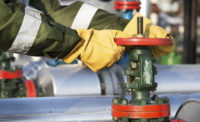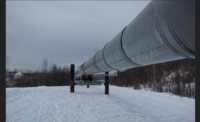U.S. DOT proposes rulemaking for the safe transportation of crude oil, flammable materials
Releases new data on Bakken crude oil to support increased safety measures

 The U.S. Department of Transportation has released the details of a comprehensive rulemaking proposal to improve the safe transportation of large quantities of flammable materials by rail - particularly crude oil and ethanol - in the form of a Notice of Proposed Rulemaking (NPRM) and a companion Advanced Notice of Proposed Rulemaking (ANPRM).
The U.S. Department of Transportation has released the details of a comprehensive rulemaking proposal to improve the safe transportation of large quantities of flammable materials by rail - particularly crude oil and ethanol - in the form of a Notice of Proposed Rulemaking (NPRM) and a companion Advanced Notice of Proposed Rulemaking (ANPRM).
The NPRM proposes enhanced tank car standards, a classification and testing program for mined gases and liquids and new operational requirements for high-hazard flammable trains (HHFT) that include braking controls and speed restrictions. Specifically, within two years, it proposes the phase out of the use of older DOT 111 tank cars for the shipment of packing group I flammable liquids, including most Bakken crude oil, unless the tank cars are retrofitted to comply with new tank car design standards.
The ANPRM seeks further information on expanding comprehensive oil spill response planning requirements for shipments of flammable materials. Both the NPRM and ANPRM are available for review here and will be open for 60 days of public comment. PHMSA says that given the urgency of the safety issues addressed in these proposals, it does not intend to extend the comment period.
“Safety is our top priority, which is why I’ve worked aggressively to improve the safe transport of crude oil and other hazardous materials since my first week in office,” said Secretary Foxx. “While we have made unprecedented progress through voluntary agreements and emergency orders, today’s proposal represents our most significant progress yet in developing and enforcing new rules to ensure that all flammable liquids, including Bakken crude and ethanol, are transported safely.”
Sound science, not "speculation"
American Petroleum Institute (API) President and CEO Jack Gerard said crude oil from the Bakken does not pose unusual transportation risks. “Multiple studies have shown that Bakken crude is similar to other crudes," said Gerard. “DOT needs to get this right and make sure that its regulations are grounded in facts and sound science, not speculation.”
The NPRM is based on an ANPRM published by the Pipeline and Hazardous Materials Safety Administration (PHMSA) last September, and reflects feedback from more than 152,000 commenters. Specifically, PHMSA will seek comment on the following provisions:
Defining the term “high-hazard flammable train” (HHFT).
Proposes a definition of HHFT as a train carrying 20 or more tank carloads of flammable liquids (including crude oil and ethanol).
Better classification and characterization of mined gases and liquids.
- Proposes development and implementation of a written sampling and testing program for all mined gases and liquids, such as crude oil, to address:
- frequency of sampling and testing;
- sampling at various points along the supply chain;
- sampling methods that ensure a representative sample of the entire mixture;
- testing methods to enable better analysis, classification, and characterization of material;
- statistical justification for sample frequencies; and,
- duplicate samples for quality assurance.
- Proposes that offerors be required to certify that sampling and testing program is in place, document the testing and sampling program, and makes program information available to DOT personnel, upon request.
Rail routing risk assessment.
- Proposes that carriers be required to perform a routing analysis for HHFT that would consider 27 safety and security factors and select a route based on findings of the route analysis.
Notification to State Emergency Response Commissions.
Proposes to codify DOT’s May 2014 emergency order that require trains containing one million gallons of Bakken crude oil to notify State Emergency Response Commissions (SERCs) or other appropriate state delegated entities about the operation of these trains through their States.
Reduced operating speeds.
- Requests comment on three speed restriction options for HHFTs that contain any tank cars not meeting the enhanced tank car standards proposed by this rule:
- a 40-mph maximum speed restriction in all areas;
- a 40-mph speed restriction in high threat urban areas[1]; and,
- a 40-mph speed restriction in areas with a 100K+ population.
- If tank cars in the HHFT meet specifications finalized in the enhanced tank car section of this rule, speed would be limited to 50-mph in all areas (rather than 40-mph).
- PHMSA also will evaluate a 30-mph speed restriction for HHFTs that do not comply with enhanced braking requirements.
Enhanced braking.
- Proposes to require all HHFTs to be equipped with alternative brake signal propagation systems. Depending on the outcome of the tank car standard proposal and implementation timing, all HHFTs would be operated with either electronic controlled pneumatic brakes (ECP), a two-way end of train device (EOT), or distributed power (DP).
Enhanced standards for both new and existing tank cars.
- Proposes new standards for tank cars constructed after October 1, 2015 (and that are used to transport flammable liquids as part of a HHFT) (e.g., thermal, top fittings, and bottom outlet protection; tank head and shell puncture resistance). PHMSA is requesting comment on three options for enhanced tank car standard requirements:
- Tank car option 1 would have 9/16 inch steel, would be outfitted with electronically controlled pneumatic (ECP) brakes and would be equipped with rollover protection.
- Tank car option 2 would also have 9/16 inch steel but would not require ECP brakes or rollover protection.
- Tank car option 3 is based on a 2011 industry standard and has 7/16 inch steel, and does not require ECP brakes or rollover protection
- Proposes to require existing tank cars that are used to transport flammable liquids as part of a HHFT be retrofitted to meet the selected option for performance requirements. Those not retrofitted would be retired, repurposed, or operated under speed restrictions for up to five years, based on packing group assignment of the flammable liquids being shipped by rail.
PHMSA will concurrently publish an ANPRM on oil spill response plans, specifically current thresholds and their applicability to rail, in part in response to an NTSB recommendation issued in January 2014.
In addition to issuing the NPRM and ANPRM, PHMSA concurrently released a report summarizing the analysis of Bakken crude oil data gathered by PHMSA and FRA between August 2013 and May 2014. The data show that crude oil from the Bakken region in North Dakota tends to be more volatile and flammable than other crude oils. Collected as part of Operation Classification (OSD), a joint PHMSA and Federal Railroad Administration (FRA) effort, the data were initially gathered to verify that crude oil was being properly classified in accordance with federal regulations, and evolved to include more robust testing to better understand the characteristics of the product.
The safety risk presented by transporting Bakken crude oil by rail is magnified both by an increasing volume of Bakken being shipped by throughout the U.S. and the large distances over which the product is shipped. In 2008, 9,500 rail-carloads of crude moved through our country compared to last year, when there were 415,000 rail-carloads. Moreover, on average Bakken crude oil shipments travel over 1,000 miles from point of origin to refineries on the coasts.
PHMSA and FRA plan to continue the sampling and analysis activities of Operation Safe Delivery through the summer and fall of 2014working with the regulated community to ensure the safe transportation of crude oil across the nation.
The rulemaking will open for public comment once published in the Federal Register at www.regulations.gov.
Looking for a reprint of this article?
From high-res PDFs to custom plaques, order your copy today!





